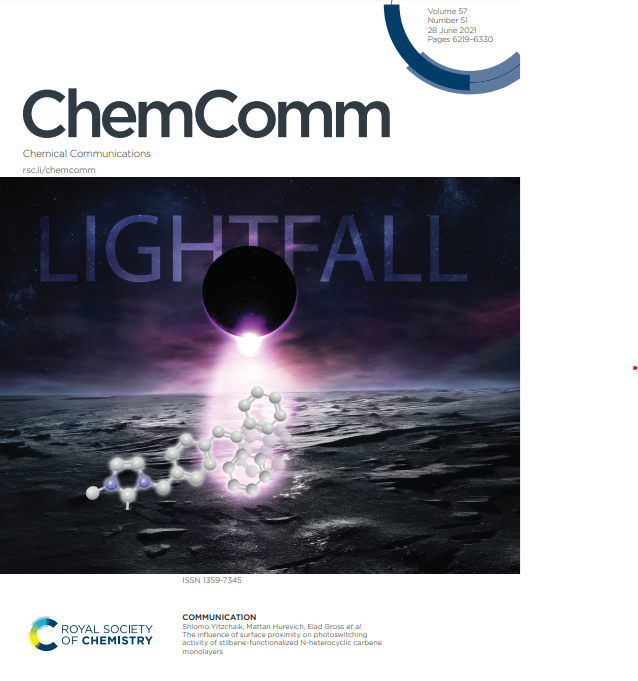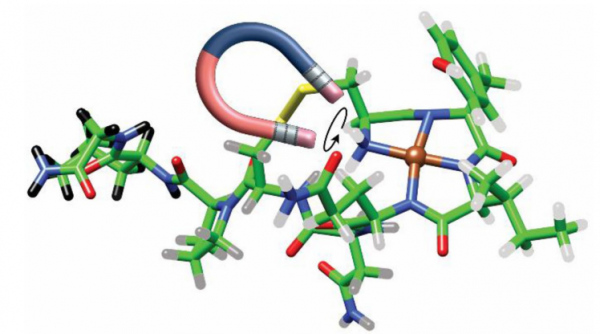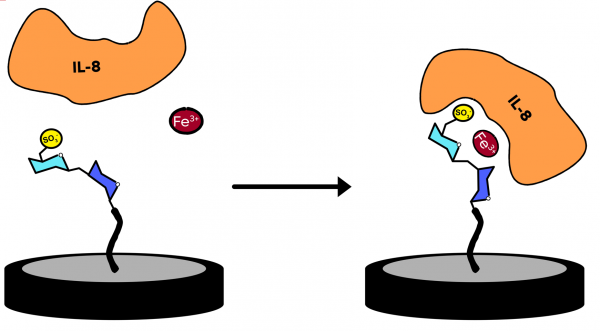S., D. ; I., A. ; E., M. ; D., F. ; S., Y. ; M., H. ; E., G. The influence of surface proximity on photoswitching activity of stilbene-functionalized N-heterocyclic carbene monolayers.
ChemComm 2021.
LinkAbstract
Self-assembly of photo-responsive molecules is a robust technology for reversibly tuning the properties of functional materials. Herein, we probed the crucial role of surface–adsorbate interactions on the adsorption geometry of stilbene-functionalized N-heterocyclic carbenes (stilbene-NHCs) monolayers and its impact on surface potential. Stilbene-NHCs on Au film accumulated in a vertical orientation that enabled high photoisomerization efficiency and reversible changes in surface potential. Strong metal–adsorbate interactions led to flat-lying adsorption geometry of stilbene-NHCs on Pt film, which quenched the photo-isomerization influence on surface potential. It is identified that photo-induced response can be optimized by positioning the photo-active group in proximity to weakly-interacting surfaces.

J., A. ; S., N. ; E., M. ; D., B. ; A., G. - D. ; I., A. ; M., R. ; M., H. ; S., Y. Non-covalently embedded oxytocin in alkanethiol monolayer as Zn2+ selective biosensor.
Sci. Rep. 2021.
LinkAbstract
Peptides are commonly used as biosensors for analytes such as metal ions as they have natural binding preferences. In our previous peptide-based impedimetric metal ion biosensors, a monolayer of the peptide was anchored covalently to the electrode. Binding of metal ions resulted in a conformational change of the oxytocin peptide in the monolayer, which was measured using electrochemical impedance spectroscopy. Here, we demonstrate that sensing can be achieved also when the oxytocin is non-covalently integrated into an alkanethiol host monolayer. We show that ion-binding cause morphological changes to the dense host layer, which translates into enhanced impedimetric signals compared to direct covalent assembly strategies. This biosensor proved selective and sensitive for Zn2+ ions in the range of nano- to micro-molar concentrations. This strategy offers an approach to utilize peptide flexibility in monitoring their response to the environment while embedded in a hydrophobic monolayer.
F., R. A. J. ; B., K. R. ; dela C, R. M. A. ; Y.-T., W. ; P.-Y., L. ; P.-C., Y. ; A., F. ; S., Y. ; Y.-J., C. Integrating site-specific peptide reporters and targeted mass spectrometry enables rapid substrate-specific kinase assay at the nanogram cell level.
Anal. Chim. Acta 2021.
LinkAbstract
Dysregulation of phosphorylation-mediated signaling drives the initiation and progression of many diseases. A substrate-specific kinase assay capable of quantifying the altered site-specific phosphorylation of its phenotype-dependent substrates provides better specificity to monitor a disease state. We report a sensitive and rapid substrate-specific kinase assay by integrating site-specific peptide reporter and multiple reaction monitoring (MRM)-MS platform for relative and absolute quantification of substrate-specific kinase activity at the sensitivity of nanomolar kinase and nanogram cell lysate. Using non-small cell lung cancer as a proof-of-concept, three substrate peptides selected from constitutive phosphorylation in tumors (HDGF-S165, RALY-S135, and NRD1-S94) were designed to demonstrate the feasibility. The assay showed good accuracy (<15% nominal deviation) and reproducibility (<15% CV). In PC9 cells, the measured activity for HDGF-S165 was 3.2 ± 0.2 fmol μg−1 min−1, while RALY-S135 and NRD1-S94 showed 4- and 20-fold higher activity at the sensitivity of 25 ng and 5 ng lysate, respectively, suggesting different endogenous kinases for each substrate peptide. Without the conventional shotgun phosphoproteomics workflow, the overall pipeline from cell lysate to MS data acquisition only takes 3 h. The multiplexed analysis revealed differences in the phenotype-dependent substrate phosphorylation profiles across six NSCLC cell lines and suggested a potential association of HDGF-S165 and NRD1-S94 with TKI resistance. With the ease of design, sensitivity, accuracy, and reproducibility, this approach may offer rapid and sensitive assays for targeted quantification of the multiplexed substrate-specific kinase activity of small amounts of sample.

I., A. ; E., S. D. ; S., Y. ; M., H. Determining the structure and binding mechanism of oxytocin-Cu2+ complex using paramagnetic relaxation enhancement NMR analysis.
J. Biol. Inorg. Chem. 2021.
LinkAbstract
Oxytocin is a neuropeptide that binds copper ions in nature. The structure of oxytocin in interaction with Cu2+ was determined here by NMR, showing which atoms of the peptide are involved in binding. Paramagnetic relaxation enhancement NMR analyses indicated a binding mechanism where the amino terminus was required for binding and subsequently Tyr2, Ile3 and Gln4 bound in that order. The aromatic ring of Tyr2 formed a π-cation interaction with Cu2+.

I., A. ; A., S. ; Y., S. ; C., U. ; M., H. ; S., Y. Effect of Interfacial Properties on Impedimetric Biosensing of the Sialylation Process with a Biantennary N-Glycan-Based Monolayer.
Langmuir 2021.
LinkAbstract
Sensing enzymatic sialylation provides new tools for the evaluation of pathological events and pathogen invasion. Enzymatic sialylation is usually monitored via fluorescence or metabolic labeling, which requires relatively large amounts of the glycan substrate with limited availability. Using a label-free biosensor requires smaller quantities of substrates because the interactions induce measurable changes to an interface, which can be translated into a signal. The downside of label-free biosensors is that they are very sensitive to changes at the interface, and the properties of the surface layer can play a major role. Electrochemical impedance spectroscopy was used here to follow the enzymatic sialylation of a biantennary N-glycan acceptor in mixed monolayers. The surfaces contained either neutral, positively or negatively charged, or zwitterionic functional groups. The systems were characterized by contact potential difference, ellipsometry, and contact angle analyses. We found that the characteristics of the mixed monolayer have a profound effect on the biosensing of the enzymatic sialylation. Positively charged layers were found to adsorb the enzyme under the reaction conditions. Negatively charged and zwitterionic surfaces were nonresponsive to enzymatic sialylation. Only the neutral mixed monolayers provided signals that were related directly to enzymatic sialylation. This work demonstrates the importance of appropriate interface properties for monitoring enzymatic sialylation processes.

Brunori F., ; K., P. D. ; I., A. ; J., F. ; J.-N., D. ; A., P. ; L., V. ; M., H. ; S., Y. Sulfation Pattern Dependent Iron(III) Mediated Interleukin-8 Glycan Binding.
ChemBioChem 2021.
LinkAbstract
Cytokines such as interleukin-8 activate the immune system during infection and interact with sulfated glycosaminoglycans with specific sulfation patterns. In some cases, these interactions are mediated by metal ion binding which can be used to tune surface-based glycan-protein interactions. We evaluated the effect of both hyaluronan sulfation degree and Fe3+ on interleukin-8 binding by electrochemical impedance spectroscopy and surface characterizations. Our results show that sulfation degree and metal ion interactions have a synergistic effect in tuning the electrochemical response of the glycated surfaces to the cytokine.

Alshanski, I. ; Sukhran, Y. ; Mervinetsky, E. ; Unverzagt, C. ; Yitzchaik, S. ; Hurevich, M. Electrochemical Biosensor based on Complex Biantennary N-Glycan for Detecting Enzymatic Sialylation Processes.
Biosens. Bioelec. 2021.
LinkAbstract
Sialylated glycans and glycoproteins are involved in cellular communication and are crucial for distinguishing between signal pathways. Sialylation levels and patterns modulate recognition events and are regulated by the enzymatic activity of sialyltransferases and neuraminidases. Abnormal activity of these enzymes is related to diseases such as cancer and viral infection. Monitoring these enzymatic activities offers valuable diagnostic tools. This work presents an impedimetric biosensing platform for following and detecting sialylation and desialylation processes. This platform is based on a native biantennary N-glycan substrate attached to a glassy carbon electrode. Changes in the molecular layer, as a result of enzymatic reactions, were detected by electrochemical impedance spectroscopy, displaying high sensitivity to the enzymatic surface reactions. Increase in the molecular layer roughness in response to the sialylation was visualized using atomic force microscopy. After enzymatic sialylation, the presence of sialic acid was confirmed using cyclic voltammetry by coupling of the redox active marker aminoferrocene. The sialylation showed selectivity toward the N-glycan compared to another glycan substrate. A time dependent sialylation was followed by electrochemical impedance spectroscopy, proving that the new system can be applied to evaluate the enzymatic kinetics. Our findings suggest that analyzing sialylation processes using this platform can become a useful tool for the detection of pathological states and pathogen invasion.

